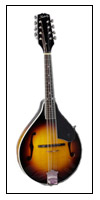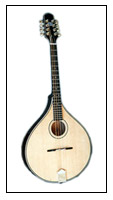 The modern mandolin comes in many shapes, although they are most often round or teardrop-shaped. Our mandolins are traditional in design, acoustic and very pleasing in tone.
The modern mandolin comes in many shapes, although they are most often round or teardrop-shaped. Our mandolins are traditional in design, acoustic and very pleasing in tone.
What is a mandolin? Mandolins evolved from the lute family in Italy during the seventeenth and eighteenth centuries, and the deep bowled mandolin produced particularly in Naples became a common type in the nineteenth century. The original instrument was the mandore (mandorla is "almond" in Italian, describing the instrument's body shape) and evolved in the fourteenth century from the lute. As time passed and the instrument spread throughout Europe, it took on many names and various structural characteristics.
The twentieth century saw the rise in popularity of the mandolin for Celtic, bluegrass, jazz and classical styles. Much of the development of the mandolin from Neapolitan bowl-back to the flat-back style (actually, gently rounded and carved like a violin) is attributable to Orville Gibson (1856–1918).
 Here at Pinelands Folk Music, we carry two types of acoustic mandolins. Kentucky has been making mandolins for over 25 years and the well-designed instrument we carry (above, right) will take you from beginner to advanced playing with ease. All of their instruments are made with select woods and produce a rich tone. Whether new to the instrument or a seasoned player, you will be pleased with a Kentucky mandolin.
Here at Pinelands Folk Music, we carry two types of acoustic mandolins. Kentucky has been making mandolins for over 25 years and the well-designed instrument we carry (above, right) will take you from beginner to advanced playing with ease. All of their instruments are made with select woods and produce a rich tone. Whether new to the instrument or a seasoned player, you will be pleased with a Kentucky mandolin.
New to the store this year is the Trinity College octave mandolin (left). Trinity College mandolins are often associated with traditional Celtic music, but may be used for a wide range of playing styles as well. This is a top quality, solid instrument created by skilled craftsmen. The body style is traditional, with decorative inlay. Its soundboard is x-braced and produces a rich, mellow tone with great projection. This is a suberb, professional instrument.
No matter which mandolin you choose, you will be pleased — and will own an instrument that will be your musical companion for years to come.






